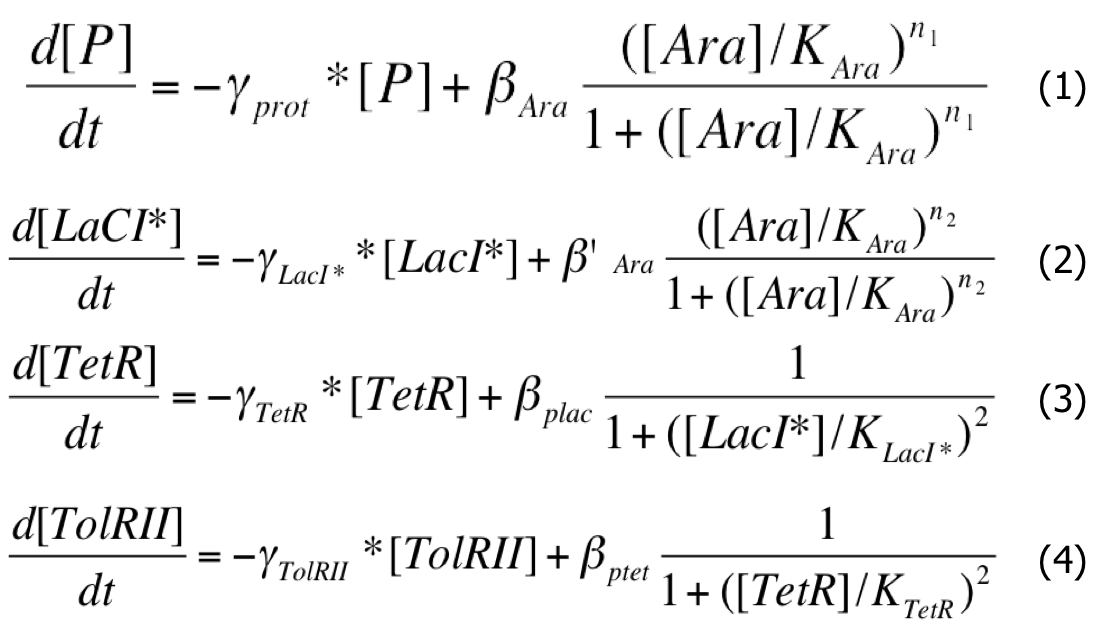Team:Paris/Production modeling
From 2009.igem.org
(→B. Modeling Vesicles creation.) |
(→B. Modeling Vesicles creation.) |
||
| Line 105: | Line 105: | ||
| - | *The Lipid conformation of the outer membrane is a well known problem: at 35°c the lipid bilayer behaves like a liquid which conformation character is ruled by an energy called the bending energy. This energy represent the fact that the lipid bilayer will search a special conformation linked to the shape and the chemical properties of its constituents | + | *The Lipid conformation of the outer membrane is a well known problem: at 35°c the lipid bilayer behaves like a liquid which conformation character is ruled by an energy called the bending energy. This energy represent the fact that the lipid bilayer will search a special conformation linked to the shape and the chemical properties of its constituents. |
| - | + | ||
| - | *The diffusion of protein in those lipid bilayers can be represented by a probabilistic Brownian movement. This diffusion model can give us the law of probability for the location of Tol and Pal on the membranes. It has been observed that the Tol and Pal proteins interact and this interaction is linked to the membrane stability: indeed the Tol and Pal will linked inner and outer membrane and furthermore stabilized the outer membrane using the peptidoglycan rigidity. | + | *Tol and Pal are membrane proteins which are located respectively in the outer and the inner membrane. The diffusion of protein in those lipid bilayers can be represented by a probabilistic Brownian movement. This diffusion model can give us the law of probability for the location of Tol and Pal on the membranes. It has been observed that the Tol and Pal proteins interact and this interaction is linked to the membrane stability: indeed the Tol and Pal will linked inner and outer membrane and furthermore stabilized the outer membrane using the peptidoglycan rigidity. |
Revision as of 09:46, 4 September 2009
iGEM > Paris > Production > Modeling
Modeling
X
A. Genetic Network Regulation
The first thing that we wanted to study in modeling was the efficiency of the construction chosen to create a delay. Our first approach was a deterministic analysis of the system using differential equations. The regulation of promoters was described using the Hill functions and the methods described by U. Alon in his book An Introduction to Systems Biology.
When the system is activated, there is Arabinose in the medium and the pBad promoters are activated. And the system can be described by this system of differential equations :
| Differential System |

|
As a first approximation, we assumed that :
- When the pBad promoter is induced, the concentration of arabinose in the medium is very high and constant during he whole study ; as a consequence, we will consider that the creation rate of Protein and LacI* is constant during the experiment :
- We considered that all the binding constants are identical and of an average of 40nM which correspond to approximately 40 monomers per cell ; we can write that :
- We chose identical intrisinc promoter activities, β , all equal to 4000 proteins/cell cycle :
- All the time units were expressed in units of cell cycle (approximately half an hour) ; as a consequence we chose a dilution rate γ of 1 for protein without special tags. For the Laci protein with a LVA tag, the dilution rate is multiplied by 3:
B. Modeling Vesicles creation.
Our model is based on three different physical phenomenon:
The lipid surface conformation , the diffusion of Tol-Pal proteins and the increase of the osmotic pressure in the periplasm:
- The Lipid conformation of the outer membrane is a well known problem: at 35°c the lipid bilayer behaves like a liquid which conformation character is ruled by an energy called the bending energy. This energy represent the fact that the lipid bilayer will search a special conformation linked to the shape and the chemical properties of its constituents.
- Tol and Pal are membrane proteins which are located respectively in the outer and the inner membrane. The diffusion of protein in those lipid bilayers can be represented by a probabilistic Brownian movement. This diffusion model can give us the law of probability for the location of Tol and Pal on the membranes. It has been observed that the Tol and Pal proteins interact and this interaction is linked to the membrane stability: indeed the Tol and Pal will linked inner and outer membrane and furthermore stabilized the outer membrane using the peptidoglycan rigidity.
- The osmotic pressure in the periplasm is the same that the medium pressure in normal time. But during the division period of the bacteria the peptidoglycan is degraded to be recycled in a new cell wall. During this phenomena of turn-over a part of the peptidoglycan is released in the periplasm which increased the osmotic pressure in the periplasm.
- We can thous consider that if there is not enough Tol-Pal linked proteins the outer membrane will deform itself to create a beginning of vesicle. But in this part of the membrane the tol pal proteins will not have the possibility to bind themselves and they will be free to diffuse in other parts of the membranes. The surface shape will guide the proteins to the border of the vesicle and stabilized the shape of the vesicle.
 "
"
